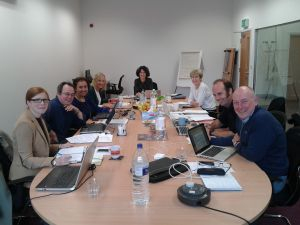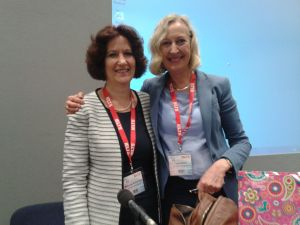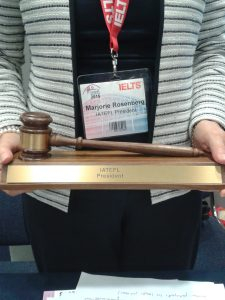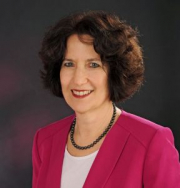Now that I am a Past President of IATEFL and finishing my term as a Trustee as Vice President, it seemed like a good time for a blogpost on how all this works.
There are eight members on the Board of Trustees and our job is the governance of IATEFL. We work together with Head Office in a number of ways. For example, they prepare the budgets which we go through and approve, they prepare other documents for us to give feedback on and have also set up training sessions for the Trustees on social media and governance in the last few years. The Trustees have three meetings a year in November, February and June and one of standing items on our agenda includes reviewing our public benefit which is defining what we do to meet our charitable aims. These include the running of IATEFL Projects, small grants given to Teacher Associations for teacher training; the WMS, or Wider Membership Scheme, which offers memberships to those who belong to our Associates in particular countries; and the WMIS, or Wider Membership Individual Scheme, which allows us to grant free memberships to teachers who do not have a Teacher Association in their countries. Other parts of our charitable mission include our free online events such as webinars and the web conference. We are also very grateful to the British Council for livestreaming our annual conference giving the chance to thousands of educators around the world to watch selected talks and interviews from the comfort of their homes or work places.
The way the system works is that a call for the VP/P position is sent out from Head Office to all members. Any member can be nominated and write a personal statement and short resume in order to stand for the VP/P position. They are encouraged to get in touch with the current president for a chat in order to gain some knowledge of what the position entails.
Once a member has been elected by the membership and then ratified at the AGM at conference, they become Vice President and Chair of the Publications Committee for their first two years as a Trustee (in the first year they are the Vice President and in the second year they hold the role of President). The Publications Committee is responsible for the IATEFL eBulletin and works with the editor of Voices to give input, answers questions from the SIG newsletter editors, and if necessary works on issues such as publishing policies and guidelines for the association. The Pubs Com Chair can also lead on special publishing initiatives and projects. In this year, the VP attends all the Trustee meetings and shadows the current President, who is Chair of the Conference Committee. This committee works closely with Head Office to organise the annual conference, the volunteers being responsible for specific aspects such as the evening programme, ‘How to … sessions’ and help with Signature Events. The Chair of the Conference Committee also suggests the plenary speakers for the upcoming conference and the final list is approved by the Board of Trustees.
At the AGM the next year (year 2), the VP becomes the President and the current President returns to the position of VP but remains Chair of the Conference Committee. The new President, currently Margit Szesztay, continues to chair the Publications Committee as mentioned earlier and takes on the job of chairing the Trustee and Advisory Council meetings as well as the AGM. The President also keeps the other Trustees up-to-date on activities and initiatives within the organisation through the President’s report. This is submitted for the three Trustee meetings held throughout the year along with the other reports written by Trustees who chair Executive Committees. The ‘new’ VP (or outgoing president) is still a Trustee in year 2 and is there to support the new President. Several months before the outgoing President’s term is up, a call for a new VP/P goes out to members and the cycle begins again.
Each president generally takes on particular projects to work on, although this is not something that has been fixed by IATEFL. In my case, I took over the ‘History of IATEFL’ which Carol Read had begun during her presidency. I was also on a committee of Trustees to recruit a new Chief Executive when Glenda Smart decided to leave for new challenges after serving the association as its Chief Executive for fourteen years. We had a number of applications and were very lucky to be able to offer the post to Jon Burton who began in August 2016. In addition, I have worked on a handbook for the IATEFL Executive Committees (Conference Committee, Publications Committee, Electronics Committee, Membership and Marketing Committee, Finance Committee and Associates Committee) and have begun the work on a handbook for the other IATEFL Committees (Proposals, Scholarships and Conference Selections). These guidelines are based on the SIG Handbook and when they are complete they will be available for all members to provide transparency at this level of the organization. Throughout our four years as VP and P, many other issues and projects arise which we take part in depending on our own strengths, interests and time. One very special event for me was being able (by video) to accept the TESOL President’s Award 2016 on behalf of IATEFL for our work in developing, linking and supporting teachers around the world, as well as getting the chance to attend the TESOL Summit on the Future of the ELT Profession in February 2017 through the kind sponsorship of the British Council.
The job itself is fulfilling and personally enriching. I am sure I speak for all past and current presidents when I say that we all learn a great deal from leading the association and taking on various projects and missions. Speaking for myself, I feel that I have grown professionally since taking on the job and have learned certain management and leadership skills which I would not have been able to learn as a classroom teacher. For me, however, the most important part of the job has been the people I have had the chance to meet and to work with. It is truly a privilege and an honour to work within the community of professionals that makes up IATEFL.
In 1981, I moved from New York City to Graz, Austria and have been teaching English to adults and university students since then. Several years after arriving in Austria I expanded into teacher training, conference presentations and writing along with getting involved with my local teacher association as well as with IATEFL. In 2003 I became Chair of TEA, Teachers of English in Austria, and in 2008 joined the IATEFL BESIG committee as an Events Coordinator, becoming SIG Coordinator in 2009. This job continued until 2015 when I became IATEFL Acting Vice President and soon after IATEFL President. My writing has included several books on learning styles as well as a wide range of materials for business English. At the moment my teaching load has decreased but my writing and travel have increased so I am as busy as ever which helps me to continue on the path of being a life-long learner. I have very happy that I have had the chance to work with so many teachers and learners throughout my career and will continue to do so as long as I can.




